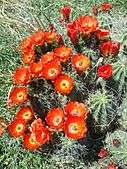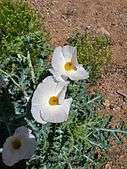El Paso Museum of Archaeology
 The sign outside of the El Paso Museum of Archaeology with the Franklin Mountains in the background. | |
 El Paso Museum of Archaeology Location within Texas | |
| Established | 1977 |
|---|---|
| Location | 4301 Transmountain Road, El Paso, Texas |
| Coordinates | 31°53′56″N 106°26′27″W / 31.898804°N 106.440842°WCoordinates: 31°53′56″N 106°26′27″W / 31.898804°N 106.440842°W |
| Type | Archaeology |
| Website | Official Site |
The El Paso Museum of Archaeology is a museum which presents information about the prehistory of the area surrounding El Paso, Texas. The museum located in Wilderness Park, and is adjacent to the National Border Patrol Museum at the base of the Franklin Mountains. It is located near several archaeological sites, including rock art in the Franklin Mountains and Mogollon pueblo sites.[1] The museum attracts about 42,000 visitors every year.[2]
History
The museum was opened in 1977.[3] The site of the museum was chosen because of the number of archaeological sites in the area.[2] Wilderness Park, where the museum is located, was established with help from the El Paso Heritage Foundation.[4] The El Paso Archaeological Society contracted with the City of El Paso to maintaine the museum.[5][6]
Exhibits and facilities
The museum has a collection of permanent archaeological artifacts reflecting 14,000 years of prehistory in the El Paso area the greater Southwest and northern Mexico.[1] The museum's artifacts have been appraised at a price of around $2 million.[2] Artifacts on display include 800-year-old agave fiber cloth, various trade items, pottery and jewelry.[7] Other items include pre-Columbian art and objects from Mexico.[7] A series of dioramas provide an insight into ancient history of the region. The dioramas depict the cultures of the Casas Grandes and Jornada Mogollon.[8]
The El Paso Museum of Archaeology has won grants to support various programs. In 2014, Humanities Texas awarded $1,000 for the support of speakers and exhibits.[9]
Festivals and activities
In the spring, the museum hosts the Annual Franklin Mountain Poppies Fest which includes flowers, activities, food and wildlife encounters.[10]
The museum offers conferences; a signature event is the biennial Jornada Mogollon Conference which takes place on odd-numbered years.[11][2]
The museum's mission statement is, "The El Paso Museum of Archaeology is dedicated to the narration, interpretation and preservation of archaeological and anthropological artifacts through research, exhibits, education, and special programs, with a focus on the prehistory and culture of the El Paso area and the Southwest". Group tours are free and available when booked in advance.[5]
Nature
Family activities include nature trails for exploring the flora, fauna and geology of the region.[12] The museum has about 15 acres of natural area surrounding the building.[13] There are over 250 varieties of native Chihuahuan Desert plants to view along a mile-long nature trail and outside of the building.[13] In addition, there are viewing areas for the Franklin Mountains, Mount Sierra Blanca and outdoor exhibits based on replicas of Apache life.[13]
| Flora from the El Paso Museum of Archaeology | ||||||||||||||||
|---|---|---|---|---|---|---|---|---|---|---|---|---|---|---|---|---|
|
See also
| Wikimedia Commons has media related to El Paso Museum of Archaeology. |
References
- 1 2 Burge, David (21 November 2011). "Curator of Archaeology Museum Wants Focus to be on El Paso". El Paso Times. Retrieved 2 May 2015.
- 1 2 3 4 Burge, David (6 February 2012). "A Future for the Past: The El Paso Museum of Archaeology on Right Path, Says Director". El Paso Times. Retrieved 2 May 2015.
- ↑ "THC – EP Archaeology Museum". Texas Historical Commission. Retrieved 24 February 2012.
- ↑ Smyrl, Vivian Elizabeth (15 June 2010). "Wilderness Park Museum". Handbook of Texas Online. Texas State Historical Association. Retrieved 2 May 2015.
- 1 2 "About Us". City of El Paso. Retrieved 24 February 2012.
- ↑ Hedrick, Carrol (12 June 2010). "El Paso Archaeological Society". Handbook of Texas Online. Texas State Historical Association. Retrieved 2 May 2015.
- 1 2 "El Paso Museum of Archeology at Wilderness Park". El Paso Southwest. 2015. Retrieved 2 May 2015.
- ↑ "El Paso Museum of Archaeology". Texas Mountain Trail Region. Texas Historical Commission. Retrieved 2 May 2015.
- ↑ "Humanities Texas grant awarded to El Paso Museum of Archaeology". Newpapertree. 14 January 2014. Retrieved 2 May 2015.
- ↑ Figueroa, Lorena (29 March 2014). "El Paso's Poppy Fest Starts Today". El Paso Times. Retrieved 6 April 2015.
- ↑ "TT EP Mus of Arch". TravelTex. Retrieved 24 February 2012.
- ↑ Buckner, Sharry; Kimball, Allan D (2006). Fun with the Family Texas. GPP Travel. p. 99. ISBN 978-0-7627-4174-8.
- 1 2 3 Eaves, Megan (2010). Insider's Guide to El Paso. Globe Pequot Press. p. 111. ISBN 9780762767014.







